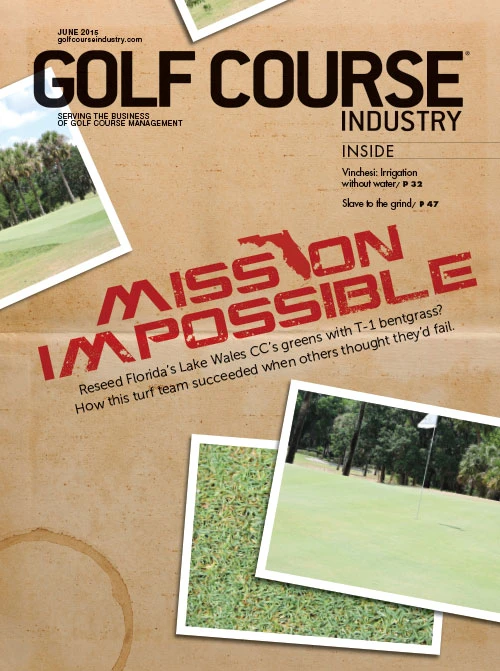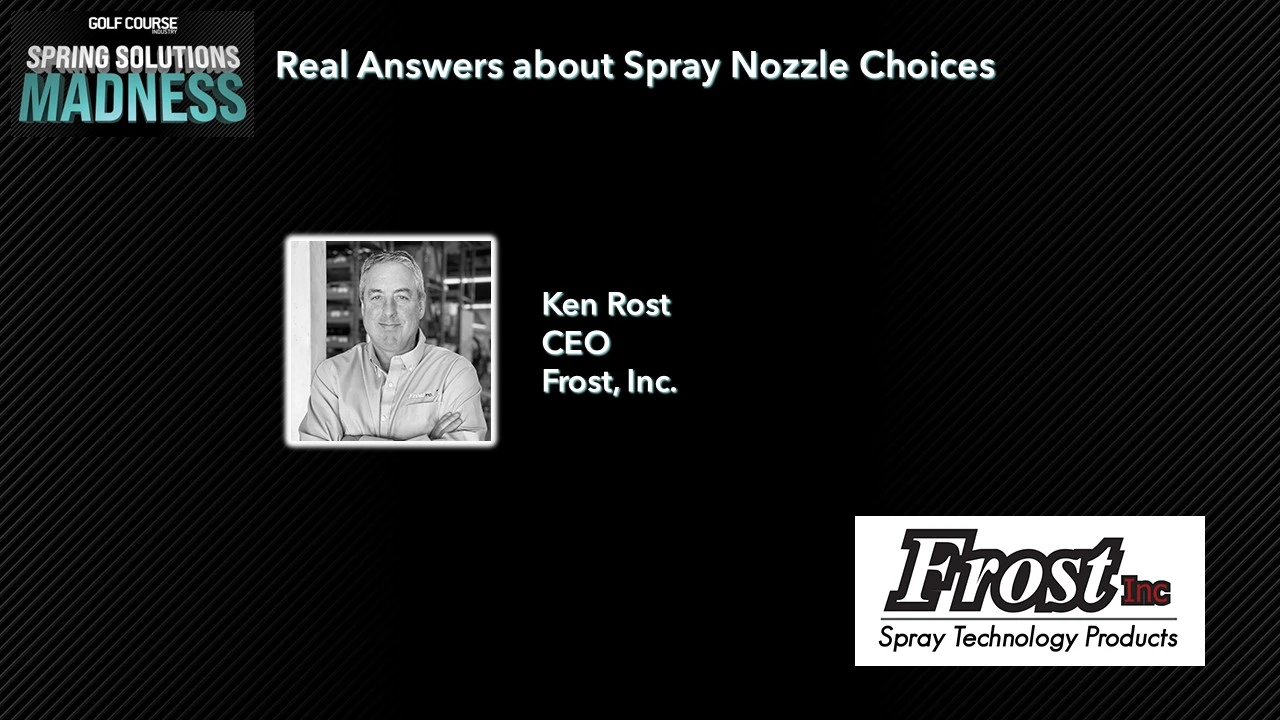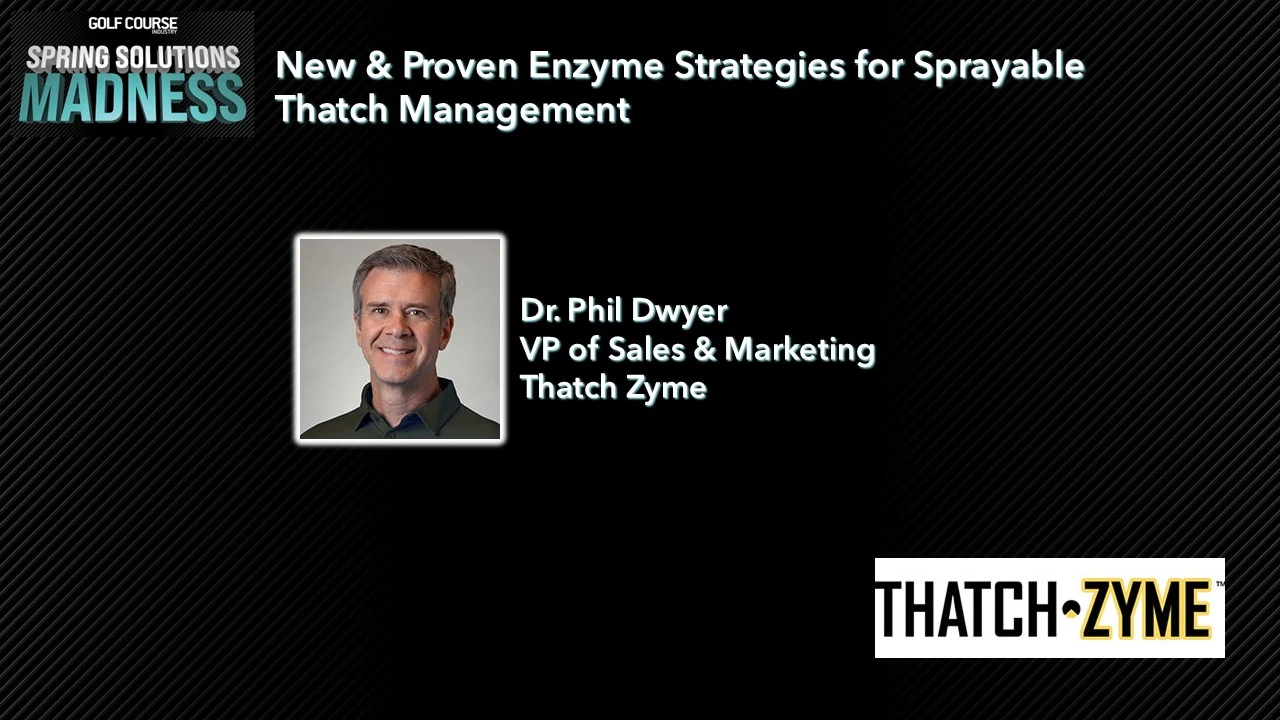 Unlike many terms sprung from modern culture or technological advances, fertigation means exactly what we might think it does – the application of fertilizers through an irrigation system. If the budget permits and a course’s irrigation system and infrastructure is functioning properly, fertigation can be an ideal way for superintendents to stimulate turf and soil health and provide uniform course conditioning.
Unlike many terms sprung from modern culture or technological advances, fertigation means exactly what we might think it does – the application of fertilizers through an irrigation system. If the budget permits and a course’s irrigation system and infrastructure is functioning properly, fertigation can be an ideal way for superintendents to stimulate turf and soil health and provide uniform course conditioning.
The alternative to fertigation is the application of dry or granular fertilizers with the use of spreaders and other machinery, or by hand in difficult to reach areas. In many cases, superintendents opt for the best of both worlds, supplementing their fertigation program with granular applications as the situation dictates. For those who must choose, the decision frequently comes down to initial cost vs. long-term savings.
“It can get kind of contentious between the liquid guys vs. the granular guys,” says Jason Gray, a technical sales representative for the Southeast for Growth Products, Ltd. “With fertigation, the application is easy and usually cheaper since there’s hardly any labor involved. Also, with granular, it’s subject to leaching and you can lose a lot to evaporation, whereas with fertigation you’re spoon-feeding continually, so it’s less wasteful.”
As for downsides to fertigation, Gray says some granular advocates claim fertigation leads to “channeling,” which he described as the irrigation tending to follow the same path in the soil, causing accumulation of fertilizers in some areas and none in others. However, that is not typically a problem except occasionally in very sandy soils, although generally plant roots will locate the nutrients and spring up there.
He also notes superintendents need to ensure fertilizers are fully soluble before they are added to the irrigation system to avoid the heavier materials sinking to the bottom of the tank and overloading the end of the irrigation cycle. As for initial cost, Gray says there is a huge variance, depending upon the sophistication and technological capabilities of the fertigation system, ranging from the most basic injection pump system around $500 to “tens of thousands” for larger, more advanced systems. He says one of the bigger units with the Dosatron system runs around $1,100.
The ease and accuracy of nutrient application are perhaps the greatest advantages of fertigation, according to Paul Roche, Rain Bird’s national sales manager for golf. Additional products like trace elements and iron can easily be added to a fertigation cycle to provide custom formulations, and nutrients can be applied at a very low rate, thus avoiding the overly fast response from turf in some cases where dry fertilizers are applied less frequently in heavier doses. He also says that fertigation allows superintendents to deliver nutrients to difficult areas like slopes and it doesn’t involve the use of tractors or spreaders which could damage seedling turf.
Downsides to fertigation, according to Roche, include the up-front cost of the equipment, the labor to install it and the cost of any containment structures required to ensure safety of storage and handling and prevent contamination. Additionally, Roche cautions that irrigation systems need to be monitored and periodically inspected to ensure that the fertilizer-enriched irrigation water is going where it is intended and providing complete coverage.
Roche says that in many parts of the country liquid fertilizers are priced competitively with dry formulations, although in both cases, local availability of materials and transportation costs can affect the price. Many superintendents say they can recoup the up-front fertigation system installation costs in the first year through savings in labor and fertilizers, according to Roche.
|
Fertigation is not for everyone While the benefits of fertigation, both in terms of even distribution of soil and turf nutrients and labor savings, are well documented, there are some courses where it's not ideal or not feasible. In today's golf economy, the initial expense of fertigation equipment such as injection and pumping systems, controllers, holding tanks and storage facilities may be a tough sell, even with the promise of potential labor and material savings to come that could pay for the system in time. The condition and scope of the course's current irrigation system is another consideration. To maximize effectiveness of fertigation practices, an irrigation system needs to deliver water uniformly to areas the superintendent needs to target with fertilizers or other materials such as wetting agents, according to Paul Roche, Rain Bird’s national sales manager for golf Roche adds that housing for the fertigation system and access to it can be problematic. Fertigation systems require a containment or protection area to prevent contamination of a site or water source by leaking fertilizer material. A fair amount of space is required for that; Roche estimates that a mid-sized pump station with fertigation will require an area of at least 24 feet by 24 feet. And, once that is constructed, there needs to be access to it to accommodate deliveries of liquid materials, or a tank fill pipeline. All of that costs money if it's not already on-site. Fertigation is somewhat less common in the cold Northeast and other snowbelt regions partially because of the need to winterize fertigation systems and tanks. Country Club of Rochester (N.Y.) superintendent Rick Holforth says he winterizes his entire irrigation system and pumping station, including the fertigation equipment, and tries to use up available liquid or soluble fertilizer before the first cold snap.
|
“Fertigation was really common earlier during the [golf course] construction boom,” he says. “Those new courses needed grow-in water and many of them had larger tanks which can be used for fertigation, although some of them are just filling those tanks halfway now. Also, a lot of golf course superintendents develop kind of a buddy system, sharing tanks and materials among several courses in an area. Superintendents today are strategically looking at how much fertilizer they’ll need and when they’ll need it, and they’ve got it down to a science.”
Superintendent Mark Burchfield of Sun Lakes Country Club in Banning, Calif., has been fertigating his courses for nearly 20 years, uses a Watertronics pump and the Inject-O-Meter injection pump and metering system and includes fertilizer nutrients such as nitrogen, iron, carbon and micro-nutrients in virtually all of his irrigation cycles.
“To me, fertigation is an excellent system to keep soil from having peaks and valleys,” Burchfield says. “It’s my opportunity to take advantage of low labor levels and also not interfere with play – sort of a stealth way to fertilize since we run the systems at night.” Robert Thorn, general manager of Clovis, N.M.-based Inject-O-Meter, says a simple fertigation pump system is available for around $1,500 and “will last forever” when it’s contained in a pumphouse and maintained.
On the other side of the country in upstate New York, Country Club of Rochester superintendent Rick Holfoth estimates that he delivers around half of his fertilizer through fertigation, and says he feels that leads to more even, steady turf growth response. He says he finds the method particularly effective in reaching difficult to fertilize areas such as green surrounds, bunker banks and hillsides. “I like it because of ease of application,” he says. “You just set it up, and once that’s done, you’re just married to your flow meter for the pump station. It’s a great tool to have.”
Holfoth cautions that with his older irrigation system, it’s necessary to prime the system and then purge it to ensure an even and steady flow of fertilizer through the system. The system also needs to be checked regularly for leaking or “weeping” heads, which will lead to excessive growth response in turf near the defective head. Holfoth tries to send his acid injection system out for cleaning every two or three years, but he admits that courses on the lower end of the budget ladder may not be able to afford the $800-$1,000 expense of factory cleaning. As far as the cost of fertigation compared to granular applications, Holfoth says, “Liquid applications are probably a touch more expensive, but with the labor savings [with fertigation], I look at it as a wash.”
Turf Feeding Systems in the Houston area designs and sells fertigation systems that the company’s owner and founder, Michael Chaplinsky, says will dramatically improve golf course sustainability and water use. Using low cost soluble nutrients applied in “spoon-feeding” or “micro-dosing” amounts and frequency, Chaplinsky has installed systems resulting in reduced water and chemical use throughout the world. Chaplinsky is passionate about his fertigation methods and their potential to produce top notch course conditioning at less cost, which he feels will help increase participation by making country club conditioning available at municipal course pricing. He is currently seeking a public course willing to participate in a case study involving Turf Feeding Systems methodology which Chaplinsky is confident will result in savings of $25,000-$30,000 per year on an investment of as little as $7,000.
One convert to the Turf Feeding Systems approach, who has taken it farther with his own experimentation in sustainable fertilization practices, is Cheyenne (Wyo.) Country Club superintendent Matt Whalen. Whalen has been with the club since 2007, when there was a turf injection system in place, but it primarily added wetting agents and iron supplements to the irrigation. In 2011, Whalen won a trip to the British Open at Royal St. George’s, where he was impressed by the sustainable ecosystem developed at Royal St. George’s and other nearby courses.
“Nothing was taken off the property,” Whalen says, “and I decided we needed to start incorporating some of that type of practice on our property. Initially, I got a hold of some Genex compost feed with nitrates and natural enzymes and hormones from healthy bentgrass for our bentgrass and Poa turf. Once I got off the other product I was using and went with Genex, we saw some Poa reduction. We also use Sobec and Humalfa, which is a dry compost, calcium nitrate in the spring and fall on the tees and fairways, and have been using Holganix, which is a semi-cryogenic compost tea, since I found out about it at a trade show in 2013. In 2013, the first year we were on the full program, we saved $75,000 in water expense because it was a particularly hot summer. Last year, which was more normal temperature-wise, we saved another $25,000 off that.”
The lower water bills were not the only savings. Whalen credits his continued employment to the Turf Feeding Systems fertigation system and his own more sustainable approach to turf health. Prior to his trip to Royal St. George’s and his “aha moment” regarding sustainable fertilization practices, turf problems at the club had members grumbling.
“After 2011, I thought I was going to be fired when our greens went down,” Whalen says. “Then I came back and went into the programs we use today whole hog. I figured if I was going to go down, I’d go down trying something my way and giving it 100 percent.
“Well, the other day, one of the guys who was trying to get me fired came up to me and says the course is in the best condition it’s ever been, and thanked me,” he adds. “We haven’t sprayed fungicide in two years, and we’re building soils for the future.”
Jim Dunlap is an Encinitas, Calif.-based writer and frequent GCI contributor.

Explore the June 2015 Issue
Check out more from this issue and find your next story to read.
Latest from Golf Course Industry
- From the publisher’s pen: Foggy intrigue
- USGA releases Water Conservation Playbook
- Vilamoura Golf courses awarded GEO Certified status
- GCSAA’s Health in Action 5K/2K reaches fundraising goal
- Landscapes Golf Management to participate in data analyzation initiative
- Reel Turf Techs: Carl Michael
- Atlanta Athletic Club approves funding for master plan
- Maximizing Cultural Practices and Agronomic Benefits with Minimal Surface Disruption






